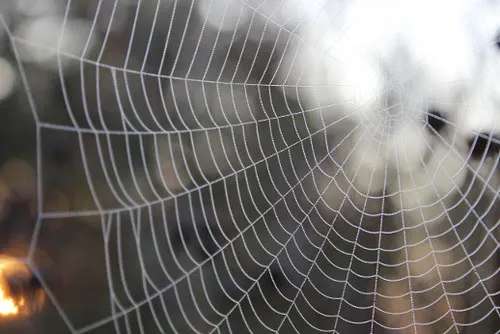
1) An individual spider web
identifies a species:
an order of instinct prevails
through all accidents of circumstance,
though possibility is
high along the peripheries of
spider
webs:
you can go all
around the fringing attachments
and find
disorder ripe,
entropy rich, high levels of random,
numerous occasions of accident:
2) the possible settings
of a web are infinite:
how does
the spider keep
identity
while creating the web
in a particular place?
how and to what extent
and by what modes of chemistry
and control?
it is
wonderful
how things work: I will tell you
about it
because
it is interesting
and because whatever is
moves in weeds
and stars and spider webs
and known
is loved:
in that love,
each of us knowing it,
I love you,
for it moves within and beyond us,
sizzles in
to winter grasses, darts and hangs with bumblebees
by summer windowsills:
I will show you
the underlying that takes no image to itself,
cannot be shown or said,
but weaves in and out of moons and bladderweeds,
is all and
beyond destruction
because created fully in no
particular form:
if the web were perfectly pre-set,
the spider could
never find
a perfect place to set it in: and
if the web were
perfectly adaptable,
if freedom and possibility were without limit,
the web would
lose its special identity:
the row-strung garden web
keeps order at the center
where space is freest (intersecting that the freest
"medium" should
accept the firmest order)
and that
order
diminishes toward the
periphery
allowing at the points of contact
entropy equal to entropy.
Identity
By A.R Ammons
(1926 - 2001)
A delightful meditation on identity and spiderwebs, questions of order and entropy beneath the moonlight...
A spider's signature in the world is its web. It draws the web from its own body and so creates a place for itself in the world. The web is an expression of the spider's identity.
The poet makes an interesting observation--
the possible settings
of a web are infinite
The world is so diverse, filled with endless variety, that it raises a dilemma: Identity is an expression within the world, it necessarily has points of attachment to the world.
how does
the spider keep
identity
while creating the web
in a particular place?
If the world is ever-different, those attachments to the varied environment mean the web, identity, must be different in every location. How then can we say that identity exists? If it takes one shape in one place and a different one in another, is there only environment and randomness?
The poet begins to weave for us a deeper understanding of how this works--
if the web were perfectly pre-set,
the spider could
never find
a perfect place to set it in: and
if the web were
perfectly adaptable,
if freedom and possibility were without limit,
the web would
lose its special identity
Life requires both pattern (identity) and adaptability (with some external limitation). Being too rigid or fixed prevents connection and the ability to act effectively in the world, yet too much flexibility of form means a loss of identity and purpose. It is in the balance of the two qualities that identity can enter into the world.
I especially like the layered insight of his final few lines. Identity and pattern is preserved within the center, where we have the greatest freedom from the world's demands, while adaptability and a certain amount of disorder at the edges allows connection to the changing world.
the row-strung garden web
keeps order at the center
where space is freest (intersecting that the freest
"medium" should
accept the firmest order)
and that
order
diminishes toward the
periphery
allowing at the points of contact
entropy equal to entropy.
A simple observation in nature, and it draws me into contemplation of the great questions.
That's it for today, will share a new one tomorrow. Happy reading.
Regards,
Wasif
Note: I am a new user here, please help me to improve blog writing.